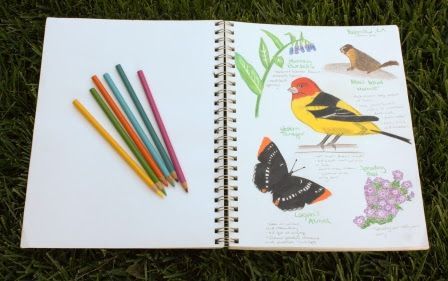Enjoying Outside, Inside: Beginner's Guide to Nature Journaling

A small notebook can be a naturalist, explorer, or scientist’s best friend. Combining detailed perceptions and inner musings, a nature journal is a way to develop your observation skills as well as encourage wonder and curiosity about your surroundings. Get to know your backyard, neighborhood, local public lands, or distant landscapes through its pages. New to nature journaling? Here are some tips to help you get started.
- Choose a dedicated nature journal. It’s easy to get distracted from your main purpose if the pages are mixed up with personal reflections, grocery lists, or To-Dos. Having a journal dedicated to your observations in nature also allows you to track your progress and observation skills, as well as changes you may observe in your surroundings. A list of other tools you may find helpful can be found here.
- Identify your goals- do you want to be a better naturalist? Gain more appreciation for the environment? Get better at identifying flora and fauna? Improve your mental health? The more clarity you have, the more likely you’ll be to get there- but remember, there’s no time frame! Nature journaling is an ongoing process and doesn’t need to have an end point.
- Every time you go out to make observations, start by noting the date, time, location, and weather to reference in the future. This will allow you to observe changes over time- such as if the Swainson's Hawks arrived earlier than last year. Noting these things at the start of the outing also serves to create some momentum so your journal doesn’t end up sitting in your backpack the whole time. This can also be a good time to make a few warm up sketches to get the juices flowing.
- Choose something interesting and explore it as a diagram, adding written notes, side views, and enlargements. Make a list of species observed. You might even want to create a table of contents to add to as you go. Observation includes seeing, hearing, smelling, and tasting (but only taste if you know what it is and that it is not harmful!). Focus on seeing something new and not as much on making it pretty.
- Try writing a narrative of the outing, including behaviors of species observed - this means slowing down and taking a moment to just watch. Pictures are a great addition to a journal - they show exactly what is out there. However, drawings can provide a different type of information that pictures may not capture. Drawing allows the observer to focus in on a specific part of the plant/animal or capture something that they didn't initially see. The Nature Journal Connection series on Youtube provides some great tips and a glimpse into the process of nature journaling.
- Remember that it’s about the process, not the product. Don’t expect your sketches to be a work of art! Especially when first getting started, your sketches and notes probably won’t live up to the vision you have in your head. This is ok! It will get easier as you get more practice, and in the end it’s really about the things you notice. Have fun and don’t be a critic of your journaling!
-Eliana Thompson; ethompson@tuleyome.org
Tuleyome Social Media and Advocacy Associate
RECENT ARTICLES






